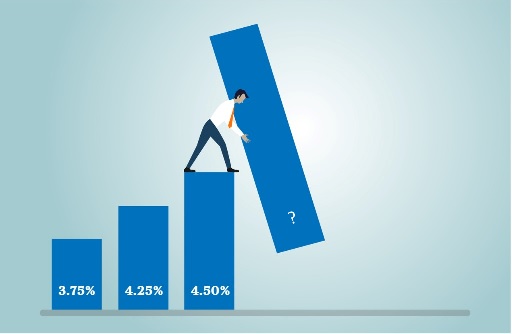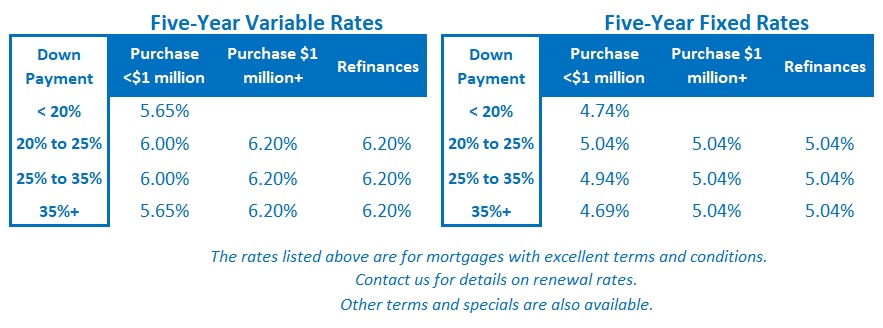Monday Mortgage Interest Rate Update
May 29, 2023The Reinvigorated Real-Estate Sector Compelled the Bank of Canada to Hike
June 12, 2023 Will the Bank of Canada (BoC) hike its policy rate when it meets this Wednesday?
Will the Bank of Canada (BoC) hike its policy rate when it meets this Wednesday?
A lot of market watchers suddenly seem to think so.
Three weeks ago, we learned that our Consumer Price Index was 4.4% in April. That result was only a little higher than our March result of 4.3%, but it marked our first monthly uptick since inflation peaked at 8.1% back in June 2022.
The bond market responded to that inflation surprise by paring back its bets on BoC rate cuts later this year.
Then, last week, we learned that our economy continued to grow at a stronger-than-expected pace in the first quarter.
Statistics Canada confirmed that our Gross Domestic Product (GDP) grew by 3.1% in Q1 on a quarter-over-quarter annualized basis. That result was above its first quarter forecast of 2.5% and well above the BoC’s most recent forecast of 2.3% in its April Monetary Policy Report. Furthermore, Stats Can had previously estimated that our GDP would decline by 0.1% (month-over-month) in April. Last week it also updated that call to +0.2%.
The bond market responded to the upside surprise in GDP by pricing in another BoC rate hike by July (which will be its next meeting after the one this week).
Thus, in the span of three weeks, the consensus has gone from betting on near-term rate cuts to betting on a near-term rate hike. Government of Canada (GoC) bond yields have spiked by 0.50% or more over that same period. The fixed mortgage rates, which are priced on them, have followed suit.
This sharp U-turn in market psychology will make it much easier for the BoC to hike this week if it is so inclined, because a hike wouldn’t surprise markets under the current circumstance. But will it?
The Bank must be concerned about how the steady flow of stronger-than-expected data is impacting consumer and business expectations about future inflation, because the expectation of higher inflation can become a self-fulfilling prophecy. But the Bank must also keep its eye on the horizon and account for the still unrealized full impact of the rate hikes it has already made. In other words, it must skate not to where the puck is but to where it is going.
When the BoC paused its rate hikes back in January, it said that it would rely on “an accumulation of evidence” to guide its next policy-rate move. Interpreting that recent evidence is somewhat complex because while the latest data confirm that our economy has continued to run hotter than expected, there is also evidence that it is beginning to cool.
For example, while we continue to add jobs at an above-average pace, that growth is occurring alongside record levels of immigration. Last month’s employment data confirmed that our supply of labour is now increasing more quickly than the demand for it. That will help alleviate some of the pressure on wage costs.
Canadian consumers have been largely maintaining their spending thus far because they have been tapping the extra savings that they built up during the pandemic. But those savings continue to be drawn down, and when they are sufficiently diminished, spending will likely slow sharply.
Our real estate markets have shown resilience in the face of higher mortgage rates, but the full economic impact of those rate increases won’t be realized until large swaths of existing borrowers must renew their mortgages. It will take time for that process to play out, but it will. And as it does, the disinflationary impact on our spending (and therefore our GDP) will be significant.
I have no doubt that the BoC will maintain its hawkish bias when it meets this week. Our stronger-than-expected data will compel the Bank to tamp down inflation expectations by reaffirming its willingness to do whatever it takes to restore price stability. But if the Bank believes that it can stall for time and stop just short of another near-term rate hike, I think that will be its clear preference.
It knows that the impact from the rapid series of hikes it has already made will continue to intensify. It also knows that fully one-third of last month’s overall price rise was attributed to higher borrowing costs – inflation of its own making.
Put me down for no move this Wednesday. The Bottom Line: Government of Canada bond yields have recently risen by 0.50% or more, and fixed mortgage rates have so far risen by a little less than that (which leads me to believe that additional fixed-rate increases could be in the offing to close the gap).
The Bottom Line: Government of Canada bond yields have recently risen by 0.50% or more, and fixed mortgage rates have so far risen by a little less than that (which leads me to believe that additional fixed-rate increases could be in the offing to close the gap).
Variable-rate discounts were unchanged last week. I don’t think the BoC will hike its policy rate when it meets this week. But what it will lack in action, it will make up with a very hawkish warning to do whatever is necessary to return inflation to target.
For now, I expect the BoC to remain in the talk-tough-and-do-nothing phase of this monetary-policy cycle.







